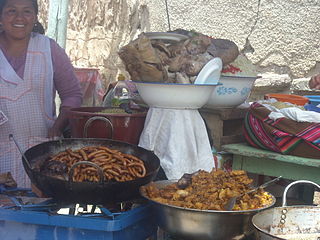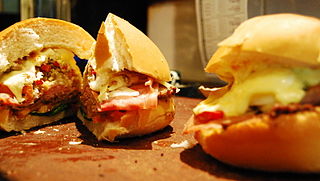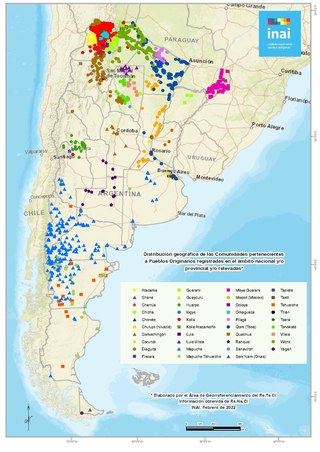
Argentine cuisine is described as a cultural blending of cultures. From the Indigenous peoples of Argentina who focused on ingredients such as humita, potatoes, cassava, peppers, tomatoes, beans, and yerba mate, to Mediterranean influences brought by the Spanish during the colonial period. This led to cultural blending of criollos, Indigenous, and sub-Saharan African in the cuisine. Later, this was complemented by the significant influx of Italian and Spanish immigrants to Argentina during 19th and 20th centuries. which incorporated plenty of their food customs and dishes such as pizza, pasta and Spanish tortilla.

A cookbook or cookery book is a kitchen reference containing recipes.

South American cuisine has many influences, due to the ethnic fusion of South America. The most characteristic are Native American, African, Spanish, Italian, Portuguese, and Indian-South Asian. However, there is a mix of European, North American, and indigenous cuisines. The customs and food products greatly vary according to the physically distinct regions.
In Spanish, the term Porteño means "port city person". It is used to refer to residents of port cities such as Buenos Aires, Argentina; El Puerto de Santa María, Spain; Valparaíso, Chile; Mazatlán, Veracruz, Acapulco and Tampico, Mexico; Puerto Cabello, Venezuela; Puerto Colombia, Colombia; Puerto Suárez in Bolivia; Puerto Cortés, Honduras; Puntarenas, Costa Rica, and Montevideo, Uruguay.

Chivito is the national dish of Uruguay. It is a sandwich of sliced beefsteak (churrasco), mozzarella, ham, tomatoes, mayonnaise and black or green olives. A chivito commonly also includes bacon and fried or hard-boiled eggs. It is served in a bun, often accompanied by French-fried potatoes. Other ingredients, such as red beets, peas, grilled or pan-fried red peppers, and slices of cucumber, may be added.

Sándwiches de miga, also called rafaelitos, are popular food items in Argentina and Uruguay, where they are often consumed at parties. Rather than making them from scratch, Argentines usually buy them at a local bakery. They can be toasted or untoasted. The toasted version is common bar food in both countries, known locally as tostados or carlitos in Argentina, and sándwiches calientes in Uruguay.

Argentina has a racially and ethnically diverse population. The territory of what today is Argentina was first inhabited by numerous indigenous peoples. The first white settlers came during the period of Spanish colonization, beginning in the 16th century. The Spaniards imported African slaves, who would go on to become the first Afro-Argentines. Following independence from Spain in the 19th century and well into the 20th century, numerous migration waves took place, with Argentina being the second most popular destination for migrants in the early 20th century, after the United States. Most of these migrants came from Europe.

Spanish is the language that is predominantly understood and spoken as a first, or second language by nearly all of the population of Argentina. According to the latest estimations, the population is currently greater than 45 million.

Afro-Argentines are people in Argentina of primarily Sub-Saharan African descent. The Afro-Argentine population is the result of people being brought over during the transatlantic slave trade during the centuries of Spanish domination in the region and immigration from Africa.

The chipa guasu is a cake made with corn grains, onions and Paraguayan cheese. It is one of 70 varieties of chipa, a traditional set of side dishes from Paraguay. It is often served in asados.

Argentina has 35 indigenous people groups officially recognized by the national government. As of the 2010 census [INDEC], some 955,032 Argentines self-identify as indigenous or first-generation descendants of indigenous peoples.

Carlos Alberto Dumas better known as Gato Dumas was an Argentine chef and restaurateur. He is considered by many the greatest chef in Argentina. He is also the founder of the largest culinary school in Latin America, the Gato Dumas Institute, with branches in Argentina, Uruguay (Montevideo) and Colombia.

Argentines, in Spanish Argentinos (masculine) or Argentinas (feminine), are people identified with the country of Argentina. This connection may be residential, legal, historical or cultural. For most Argentines, several of these connections exist and are collectively the source of their being Argentine.

The cuisine of Paraguay is the set of dishes and culinary techniques of Paraguay. It has a marked influence of the Guaraní people, in fusion with the Spanish cuisine and other marked influences coming from the immigration received by bordering countries such as Italian cuisine and Portuguese food. The gastronomy product of the syncretism and Hispanic-Guaraní fusion, is of greater weight in the Paraguayan history and considered the mother of the whole region, having Asunción as the starting point of many Spanish expeditions in the Southern Cone. It is worth clarifying that in society Paraguayan, the exchange of knowledge occurred between mestizos, criollos and guaraníes, before and even after the Jesuit missions. In 2017, the Ministry of the National Secretariat of Culture of Paraguay decided:
"Declare as 'Intangible Cultural Heritage of Paraguay' the production, handcrafted and traditional production of four typical Paraguayan meals still in force such as vori-vori, locro, Paraguayan soup and jopara and its recipes, knowledge, practices and knowledge that are passed down from generation to generation and document the material and immaterial elements associated with it as a cultural manifestation. "

General elections were held in Argentina on 25 October 2015 to elect the President and National Congress, and followed primary elections which were held on 9 August 2015. A second round of voting between the two leading candidates took place on 22 November, after surprisingly close results forced a runoff. On the first runoff voting ever held for an Argentine Presidential Election, Buenos Aires Mayor Mauricio Macri narrowly defeated Front for Victory candidate and Buenos Aires Province Governor Daniel Scioli with 51.34% of votes. As of 2021, his vote count of nearly 13 million votes makes it the highest number of votes any candidate has ever received in Argentinian history. He took office on 10 December, making him the first freely elected president in almost a century who was not either a Radical or a Peronist.

General elections are scheduled to be held in Argentina on 22 October 2023, to elect the president, members of the national congress and the governors of most provinces. Incumbent president Alberto Fernández, despite being eligible for a second term, has announced he will not seek reelection.

Argentine cheese is by far the most produced dairy product in the country, making Argentina the second largest cheese producer in Latin America and among the top 10 cheese-producing countries in the world. In addition, Argentina is the Latin American country that consumes the most cheese, with 12 kilos per capita per year. Production is mainly centered in the provinces of Córdoba, Santa Fe and Buenos Aires, in the Pampas region of the central and east-central parts of the country.
María Bernarda Seitz, better known as La Hermana Bernarda, was an Argentine Roman Catholic nun, writer, chef, and television presenter.

Antonio Gonzaga, also known as El Negro Gonzaga, was an Argentine chef and cookbook writer. His 1931 book, El cocinero práctico argentino is credited as the first cookbook published in Argentina.
















